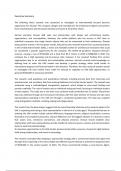Executive Summary
The following thesis research was conducted to investigate an internationally focused business
opportunity for Aectual. The company designs and manufactures 3D architectural objects and systems
from recycled plastic and bio-based materials and owns XL 3D printer robots.
Aectual primarily focuses B2B sales and partnerships with design and architectural studios,
organizations, and municipalities. However, the online platform also has success in B2C sales as
individual consumers buy single interior objects that can be customized to their preferences. Despite
being present mainly in the European market, Aectual has also received income from occasional projects
in the United Arab Emirates (UAE), a niche and desirable market for architectural innovation that could
be considered a growth opportunity for the company. The COVID-19 pandemic impacted Aectual's
revenue, causing a loss of €765,000 and a drop from €1.5 million in 2019 to €488,000 in 2020. The
company has a high operating cost-to-revenue ratio, however, it has received funding from various
organizations due to its circularity and sustainability practices. Aectual currently lacks knowledge on
defining how to enter the UAE market and develop a growth strategy, which could hinder its
international progress and financial health in this direction. Therefore, the main research question aimed
to investigate the best market entry mode for Aectual to capitalize on UAE B2B opportunities, to
generate €100,000 in revenue by Q2 2023.
The research used qualitative and quantitative methods, including primary data from interviews and
questionnaires and secondary data from existing databases and market trends reports. The research was
conducted using a methodological triangulation approach, which helped to cross-check findings and
provide credibility. The unit of analysis was on individual and group levels, focusing on individual analysis
of sales experts. The study was a one-shot cross-sectional study conducted over 15 weeks. The primary
data was collected through semi-structured interviews with the Sales Director of Aectual and two sales
representatives operating in the UAE and through a conducted questionnaire. The data was analyzed
using triangulation methods, including coding and categorization.
The results from the data analysis suggest that the most financially attractive entry mode to adopt in the
UAE is exporting and having a local representation in the form of a sales agent. The potential barriers to
entering the UAE market include cultural differences, language barriers, religious sensitivities, currency
fluctuation and complex bureaucracy. Cultural differences are the biggest obstacle to a business culture
that values trust, emotional connections, and physical presence. Aectual should establish close
relationships with local representatives and be mindful of cultural nuances, customs and communication
styles to avoid misunderstandings.
To maximize opportunities in the UAE market, Aectual should utilize resources, choose the right location,
build strong relationships, and invest in technology.
The research concluded that adopting a sponsorship strategy with a commission-based sales agent and
through direct exporting is the most suitable and effective way for Aectual to achieve the projected sales
of €100,000 in the second quarter of 2023. The thesis recommends finding a Local Service Agent,
,attending architecture and design events, and initially establishing Aectual in Dubai as the most suitable
entry city due to Aectual's previous projects and established contacts. A cost-benefit analysis and an
implementation plan back this.
, Table of Contents
Chapter 1. Introduction 6
1.1 Background of the research 6
1.2 Company description 6
1.2.1 Circular Values 7
1.2.2 Revenue Model 7
1.3 Opportunity analysis 8
1.3.1 Current situation 8
1.3.2 3D printing construction and trends in the UAE market 9
1.3.3 Desired situation 11
1.3.4 Gap 11
1.4 Main research question 12
1.5 Organization of the report 12
Chapter 2. Theoretical framework 13
2.1 Introduction 13
2.2 Theoretical perspectives on the topic 13
2.2.1 Theoretical perspectives on internationalization and foreign market entry strategies 13
1) Market Entry modes in the Middle East and a sponsorship strategy 15
2.2.2 Theoretical perspectives on Cultural Distance 15
2.2.3 Transaction cost theory 16
2.2.4 Institutional theory 17
2.2.5 Resource-based view theory 18
2.2.6 The theory of the firm's growth and the U-model 18
2.3 Limitations of the selected theory 19
2.4 Sub-questions 19
Chapter 3: Research Methodology 21
3.1 Introduction 21
3.2 General elements of the research study 21
3.2 Sub-question 1: “Which kind of entry mode is the most financially interesting to adopt in the UAE
market?” 22
3.2.1 Methods of data collection 22
3.2.2 Methods of data analysis 23
3.3 Sub-question 2: “What are the potential barriers and challenges to entering the UAE market? ” 24
3.3.1 Methods of data collection 24
3.3.2 Methods of data analysis 26
3.4 Sub-question 3: “What are key principles for SMEs to maximise opportunities in the UAE
market?” 26





